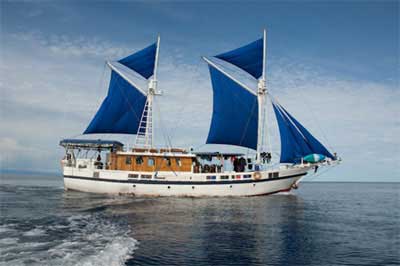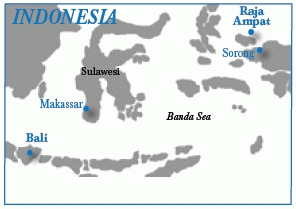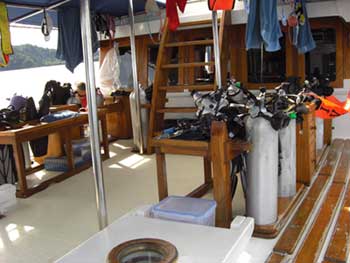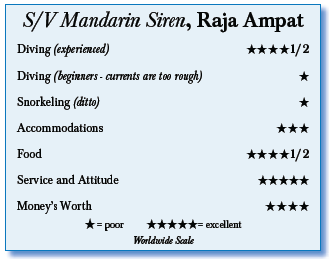S/V Mandarin Siren, Raja Ampat, IndonesiaContents of this Issue: S/V Mandarin Siren, Raja Ampat, Indonesia The Latest Smuggling Device: Scuba Scooters The Cost of Search and Rescue Missions For Regulators, Light is Right Think Twice Before Putting Your Gear in Rinse Tanks Legal Complications of Being Injured Abroad Is Closing Reefs to Divers the Best Way to Protect Them? Editorial Office: Ben Davison Publisher and Editor Undercurrent 3020 Bridgeway, Suite 102 Sausalito, CA 94965 and a starter with Baliís AquaMarine Diving from the March, 2011 issue of Undercurrent
Dear Fellow Diver: More than 30 liveaboards visit Raja Ampat. Getting to them is arduous, and after two liveaboard trips there, I think I found the same (and more) critters, fish, and coral for much less trouble when I dived northeast and southeast Sulawesi -- and with much easier travel. My recent trip was on S/V Mandarin Siren, one of Worldwide Dive and Sail's newest boats. It was highly professional, well-run and interesting. But I still wonder: Why is this area so hot? Does this mean Raja Ampat doesn't offer some great diving? Not at all. My log cites amazing creatures, including the blue-ring octopus, colorful mantis shrimp, sea fans big enough for two divers to hide behind, pygmy seahorses everywhere, barrel sponges as large as washing machines, turtles, mantas, rays, and glorious coral terraces sparkling with color and filled with life. Though I did see plenty of fish, there were rarely clouds of barracuda or jacks, and few sharks. I just question why so many divers are spending time and money going there when they can spend less, live on shore and see more in Sulawesi. Go ahead and hate me.
All Raja Ampat liveaboards depart from Sorong in Papua. Getting there from Bali requires a short flight to Makassar, overnighting, then a flight to Sorong the next morning (flights are often canceled or rescheduled). The Makassar airport is swank, but Sorong's is hot, crowded, small, smelly, and the return flight meant hours in the miserable waiting area. On this trip, only moments after arriving, Mandarin Siren's Dierdre Moore had me corralled and comfortable, while she ran interference on the bags.
Alternating rain with patches of sun was typical among the many islands of Raja Ampat. Moderate to strong currents were also the rule. Dive sites ranged from muck, coral, fish and critter, to scenery dives. Water was in the low 80s. Pulau Farondi's beautiful swim-through not only silhouetted divers, but also offered plump bargibanti pygmy seahorses and massive bumphead parrotfish. Mayhem at Pulau Yangeffo featured juvenile pinnate batfish, clouds of Moorish idols, jacks, fusiliers and rainbow runners, as well as a virtual carpet of wobbegong sharks. Gam Ridge was rich with schooling jacks, barracudas, batfish, fusiliers, some blacktip sharks, a nearly somnambulant juvenile wobbegong and hawksbill turtles. Indeed, on many dives you can't avoid seeing the wobbegong, whose "carpet shark" nickname is apt. Its flat, reticulated surface is fringed with whiskers, and its seeming sloth often keeps the carpet stationary. The best dives for me were at Manta Sandy, a sand patch next to a sparse reef. Giant Pacific mantas come here to be groomed by schools of wrasse and angelfishes. They line up the way we do at the bakery: Take a number and wait your turn. Some were entirely black, some had white on black bellies, some black on white -- each unique, like a fingerprint. I saw 22 on one dive. The grace of these giants was mesmerizing but the sand patch beneath was macro heaven, with pygmy pipe seahorses and exquisite Pegasus sea moths. I turned back and forth, admiring wingspans up to 22 feet overhead while using my 10x magnifying glass to delight in the tiny stuff. Hard to beat. The 80-foot Mandarin Siren attracted me because it takes only six divers in four cabins, so it can dive sites the bigger boats can't. It's billed as a luxury liveaboard, with a computer setup in each cabin (no internet but you could upload photos and watch DVDs) and either twin bunks or larger beds in the V-berths. Storage is tight but manageable. Ensuite bathrooms were small and typical of liveaboards in Asia; the toilet, sink, and shower are in one small room, along with a bidetlike hose near the toilet, sometime leaving a small puddle on the floor, which felt funky if I crept in at night. They could solve this problem with a wooden grate over the floor.
The attentive, kind and hard-working staff made the tight quarters feel more luxurious. Cruise director and divemaster Dierdre Moore was charming, hilarious, and worked like a Trojan -- she really made the trip. She fit the itinerary to divers' interests and weather, showing flexibility rare on many liveaboards. She brought us north to the Yangeffo and Gam area, a 15-hour transit during which we enjoyed restful, restorative bunk diving. She checked sites prior to going in to make sure our entries fit the currents and the site. I also admired her briefings. Not only did she draw excellent underwater maps but included mnemonics for special sights (such as "the pink fan at 10 meters is right in front of the disco clam"). Dierdre created a trip narrative and careful log of all 34 dives, printed out for us at the end of the trip. Nita, the housekeeper, doubled as a fine massage therapist. Eagle-eyed dinghy driver Michael also worked as a part-time captain, steward and dive gear wrangler. Ari, the engineer helped with any technical problem as well as dive gear, and Captain Deng brought us safely through a bad squall.
If you are a photographer, the electronics will delight -- direct computer hookup to a large flat-screen TV in the salon -- but the small dive deck size means you might have to keep some of your gear in the salon. The two photographers on this trip worked it out, but I cannot imagine that boat hosting more than two gear-intensive photographers without fistfights. The dive deck was carefully organized, with drawers for masks, defog, gloves and so forth. Once my BC was on my tank, it stayed there. All dives were done on Nitrox, which was included in the trip price. The dive staff does everything for you, including washing wetsuits and skins in an antibacterial solution. Dives are done from an inflatable, entering with a backroll. The crew helped me put on my BC in the water when my back hurt, and if I surfaced early or distant, Michael found me immediately. He hauled in my BC, tank, fins and weights, because the ladder was short and the round steel "steps" challenging to ascend. A few dolphin-hybrid divers simply kicked their way over the side. I liked the intimacy of the Mandarin Siren, but had I not booked with close friends, it might have soured. The upsides are no crowded dive sites and great service, the downside is that though efficient, the boat is small. But the last time I dove Raja Ampat was on a large liveaboard, and this time I loved not getting pushed aside by videographers with giant rigs or being stuck in a crowd. But don't overpack. All you need besides swimsuits and dive gear are sweats, tees, sarongs and shorts. I would definitely book with Worldwide Dive and Sail again. I have never enjoyed such attentive service on a boat, as well as quick responses to pre-trip queries. The company seems committed to service. But I wouldn't dive Raja Ampat again. I believe it has too many liveaboards, and its diving is not clearly better than easier areas to reach (like Manado/Lembeh/Bunaken or Wakatobi on Sulawesi) to merit the expense and difficulty of getting there. I respect the care dive advocates like Maurine Shimlock and Burt Jones give Raja Ampat (their book, Diving Indonesia's Raja Ampat, is beautiful, informative and required reading for diving the area), and perhaps there's a great trip there I just don't know of. Convince me, deliver the goods, and I'll go. I began and ended this trip in Bali. After an 18-hour flight to Hong Kong and connection the next day to Bali, I hopped into a van from Aquamarine Diving for a 3.5 hour ride over the mountains of central Bali in dense fog and rain on hairpin turns and over enormous potholes to the Menjangan Island area. My dive buddy and I were the only Americans staying at Puri Ganesha villas in Permuteran, but $800 per night in this inexpensive country keeps many away unless you have a reason to splurge. Our villa had two floors with enormous porches and a private pool, long enough for laps. The living room had an iPod dock; outside was a small bale to take meals or relax in. Puri Ganesha is quirky and rustic, with touches of luxury and cheap irritations. Each villa is staffed by a butler and maid who serve you from the limited breakfast menu, bring towels and see to your needs. Yet power outlets were scarce, the dark towels dried slowly if at all, and illumination in the villa was generally suitable for owls rather than aging human eyes. Furnishings are largely antiques and handmade, meaning texture and beauty but not sleek or modern. If the latest in spa equipment or electronics is what you want, don't come here. The food is delicious, and owner Diana Von Cranach prides herself on creating dishes reflecting local offerings. Beware the cocktail called the Elephant's Footprint -- made from quality Arak, juices and spices, it goes down easily and packs a wallop. The small spa is staffed by Putu, a local Balinese healer and priest whose hands seek out what ails you and can even leave you bruised but ultimately feeling better. For years, I have used expat Brit Annabel Thomas's AquaMarine Diving when in Bali. Being detail-minded, she is my kind of person, so when the plane touched down, the service began with expedited immigration and customs for an extra $30 per traveler (well worth it -- I was out of the airport in 20 minutes). AquaMarine's vans, all Isuzu diesels, are roomy but noisy, particularly when hauling you over mountains and rough roads. My dive buddy described Balinese traffic as schooling fish -- all driving on what we think is the wrong side of the road, yet they seem to sense who is where -- but it's hairy for an American. Word to the wise: Leave driving to the locals. AquaMarine staff picked me up from Puri Ganesha at 8 a.m. on my first dive day and drove to the port from which local boats put-put out to Menjangan Island. Mud and dirty bathrooms with Turkish toilets come with. The constant rain had washed up a huge amount of garbage on its volcanic sand, and the winds and currents brought garbage into the waters around the dive sites. There is no regular garbage service for Bali, so people throw it in the rivers, where it washes out to sea, especially during the rainy season. The Jakarta Post ran an article about garbage on Balinese beaches and local efforts to clean them up, yet despite some folks' efforts, garbage floated around dive sites and washed up on the beaches. The ride to Menjangan Island in a small wooden boat was slow, about 30 minutes, with unpadded seats making it feel longer. But the captain and Aan, the divemaster, were excellent, wrangling gear and choosing sites as conditions allowed. Indeed, Aan was extraordinary, not just in finding creatures but in service. My dive buddy's pressure with a proprietary slip-off mount broke and Aan Mcguyvered a neat substitute that won't fall off and fits virtually all mounts. But not even his competence could control the weather. Rough seas confined us to the less interesting leeward side of the island. The third day of diving succumbed to howling winds and rains, and I gave up trying to dive an area afflicted with undiveable weather. The best of the five dives I did was at Temple Point, just past the leeward side. Its small wall yielded eels as burly as tree trunks, as well as small flame dartfish, several species of anemonefishes (including the rare biocellatus) and a large cuttlefish. But I can't form a valid opinion about the diving, as five dives in a small leeward area of Menjangan hardly qualifies me to review the area. Again, when planning a trip, keep seasons in mind. Ironically, I chose northwest Bali because it had the reputation for being sunny and dry even in the rainy season, and because I had never been there. Menjangan Island and Secret Bay were the first Balinese dive areas to be discovered, and though they have suffered from being overly loved, I was eager to see a new area. Secret Bay (which we never got to due to bad weather) is known for muck, whereas Menjangan Island offers coral patches, mini-walls, and bigger animals. Eastern Bali, off Manggis and Padangbai, is an exciting area of small islands, fierce currents, thermoclines, great corals and always thrilling diving, though not recommended for anyone uncomfortable with current. The channel between Bali and Lombok mixes the Pacific and Indian oceans, with serious tidal changes. The upside is the chance to see creatures belonging to both oceans. -- A.E.L.
|

I want to get all the stories! Tell me how I can become an Undercurrent Online Member and get online access to all the articles of Undercurrent as well as thousands of first hand reports on dive operations world-wide
| Home | Online Members Area | My Account |
Login
|
Join
|
| Travel Index |
Dive Resort & Liveaboard Reviews
|
Featured Reports
|
Recent
Issues
|
Back Issues
|
|
Dive Gear
Index
|
Health/Safety Index
|
Environment & Misc.
Index
|
Seasonal Planner
|
Blogs
|
Free Articles
|
Book Picks
|
News
|
|
Special Offers
|
RSS
|
FAQ
|
About Us
|
Contact Us
|
Links
|
3020 Bridgeway, Ste 102, Sausalito, Ca 94965
All rights reserved.


 As Mark Twain was credited with saying,
"Everybody talks about the weather but nobody
does anything about it." During my January
trip, it rained and rained, and the sun
never appeared for half of the days. (People
told me there had been no dry season last
year). I'm no Gene Kelly; raining does not
make me sing. Because the weather affects so
much, prepare for your trip by checking sites
like NOAA (
As Mark Twain was credited with saying,
"Everybody talks about the weather but nobody
does anything about it." During my January
trip, it rained and rained, and the sun
never appeared for half of the days. (People
told me there had been no dry season last
year). I'm no Gene Kelly; raining does not
make me sing. Because the weather affects so
much, prepare for your trip by checking sites
like NOAA (
 Food was created in a minute galley
by Chef Andre, and each meal
offered fresh fruits and creative,
well-presented western and Indonesian
options. Provisions come largely from
Sorong, so don't expect the finest meats or veggies, but Andre worked hard to make
the beef or chicken tender and, if not, at least very tasty. He did not overspice
food but created intensely hot sambals for me when I requested. Dinner always
began with a soup, followed by a display of dishes that Andre described. Most meals
offered three entrees and at least three side dishes. Beer and soft drinks were
included, and one could buy bottles of wine for $42 or cocktails for about $7. The
salon coffeemaker ground beans on demand and created coffee ranging from espresso
to regular.
Food was created in a minute galley
by Chef Andre, and each meal
offered fresh fruits and creative,
well-presented western and Indonesian
options. Provisions come largely from
Sorong, so don't expect the finest meats or veggies, but Andre worked hard to make
the beef or chicken tender and, if not, at least very tasty. He did not overspice
food but created intensely hot sambals for me when I requested. Dinner always
began with a soup, followed by a display of dishes that Andre described. Most meals
offered three entrees and at least three side dishes. Beer and soft drinks were
included, and one could buy bottles of wine for $42 or cocktails for about $7. The
salon coffeemaker ground beans on demand and created coffee ranging from espresso
to regular.  Diver's Compass: Cathay Pacific, my preferred airline, flies directly
to Hong Kong from JFK, SFO, and LAX, with connecting flights
to Bali via Hong Kong . . . Other options include Continental via
Hong Kong (the better HKG airport hotel is the Marriott if you need
to stay over) or Singapore Airlines via Singapore . . . Flights
between Bali, Makassar and Sorong average $150 per leg, so budget
at least $500 for inter-island travel; the planes are uniformly
uncomfortable for anyone over 5'5". . . A 10-day trip on the
Mandarin Siren is about $3,000, depending on the exchange rate; for
Raja Ampat, a marine park fee of $110 for the 10-day trip is mandatory . . . The
boat offers 3mm shorties, regulators, BCDs and fins at no extra charge; if you lack
a computer, they rightly require you to use one of theirs at $7 per day . . . The
bill for drinks, other purchases and tips must be paid in cash at the end of the
trip, so come prepared; they accept U.S. dollars, Euros, U.K. pounds and the local
currency of Indonesian rupiah), and ATMs work in some places (staff knows where)
. . . I highly recommend the books Reef Fish Identification: Tropical Pacific and
the new Reef Creature Identification: Tropical Pacific, available at
Diver's Compass: Cathay Pacific, my preferred airline, flies directly
to Hong Kong from JFK, SFO, and LAX, with connecting flights
to Bali via Hong Kong . . . Other options include Continental via
Hong Kong (the better HKG airport hotel is the Marriott if you need
to stay over) or Singapore Airlines via Singapore . . . Flights
between Bali, Makassar and Sorong average $150 per leg, so budget
at least $500 for inter-island travel; the planes are uniformly
uncomfortable for anyone over 5'5". . . A 10-day trip on the
Mandarin Siren is about $3,000, depending on the exchange rate; for
Raja Ampat, a marine park fee of $110 for the 10-day trip is mandatory . . . The
boat offers 3mm shorties, regulators, BCDs and fins at no extra charge; if you lack
a computer, they rightly require you to use one of theirs at $7 per day . . . The
bill for drinks, other purchases and tips must be paid in cash at the end of the
trip, so come prepared; they accept U.S. dollars, Euros, U.K. pounds and the local
currency of Indonesian rupiah), and ATMs work in some places (staff knows where)
. . . I highly recommend the books Reef Fish Identification: Tropical Pacific and
the new Reef Creature Identification: Tropical Pacific, available at 